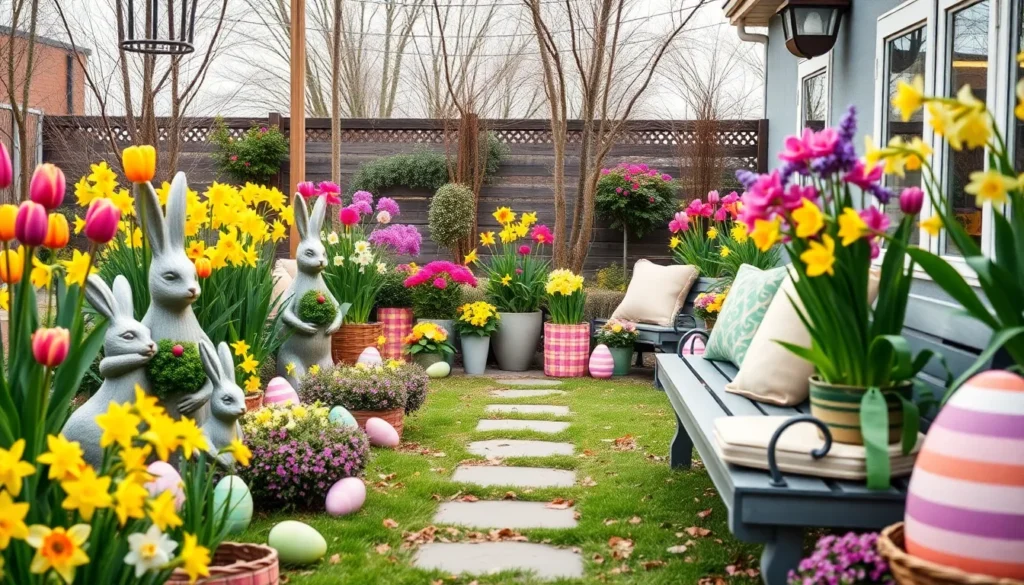Spring’s arrival brings the perfect opportunity to transform our outdoor spaces into vibrant Easter celebrations. We’re about to discover how simple garden decorations can create magical springtime displays that’ll have neighbors stopping to admire our creativity.
Easter garden ideas don’t require a green thumb or massive budget – just a little imagination and some colorful touches. From whimsical bunny planters to pastel flower arrangements we can create stunning displays that capture the season’s joy. These DIY projects work beautifully whether we’re decorating sprawling backyards or cozy balcony gardens.
We’ll explore everything from traditional Easter egg hunts enhanced with garden features to modern container gardens bursting with spring blooms. Ready to create an Easter wonderland that’ll become the highlight of our neighborhood celebrations?
Create a Whimsical Easter Bunny Garden Display
Transform your outdoor space into a charming bunny wonderland that captures the playful spirit of Easter. Strategic placement and creative elements will bring magical charm to your garden celebration.
Position Decorative Rabbit Statues Strategically
Place larger bunny statues near your garden’s focal points like doorways, pathway entrances, or central flower beds. We recommend positioning a family of ceramic or resin rabbits at different heights to create visual interest and natural groupings.
Cluster smaller rabbit figurines around tree bases or along garden borders where they’ll peek out between plants. Stone and weatherproof resin options work best for outdoor displays that need to withstand spring weather conditions.
Angle your bunny statues to face walking paths or seating areas so visitors naturally discover these delightful surprises. Mixed sizes from 6-inch garden rabbits to 18-inch statement pieces create depth and whimsy throughout your Easter garden display.
Add Bunny-Themed Planters and Garden Stakes
Select bunny-shaped planters in pastel colors like soft pink, lavender, or cream to hold your spring flowers. We’ve found that coconut fiber and ceramic bunny planters work exceptionally well for displaying pansies, primroses, and small bulb flowers.
Install decorative garden stakes featuring rabbit silhouettes or bunny faces throughout your flower beds. Metal stakes with powder-coated finishes resist rust while adding vertical interest to low-growing spring plantings.
Fill traditional planters with bunny ear-shaped plants like lamb’s ear or dusty miller for subtle themed touches. Wooden bunny cutouts on stakes also work beautifully when painted in weather-resistant colors that complement your garden’s palette.
Incorporate Carrot-Shaped Garden Markers
Insert orange carrot-shaped garden stakes between your bunny displays to create cohesive Easter storytelling. We suggest using foam, wood, or metal carrot markers that range from 8 to 12 inches tall for optimal visual impact.
Label your vegetable garden rows with carrot-shaped plant markers for both function and Easter theming. Painted wooden carrots or ceramic options work perfectly for identifying herb and vegetable plantings while maintaining your festive garden theme.
Group carrot markers in odd numbers near bunny statues to suggest the rabbits are discovering garden treats. DIY carrot stakes made from painted dowels with green felt tops offer budget-friendly options that children can help create for your Easter garden display.
Design a Colorful Easter Egg Hunt Garden Path
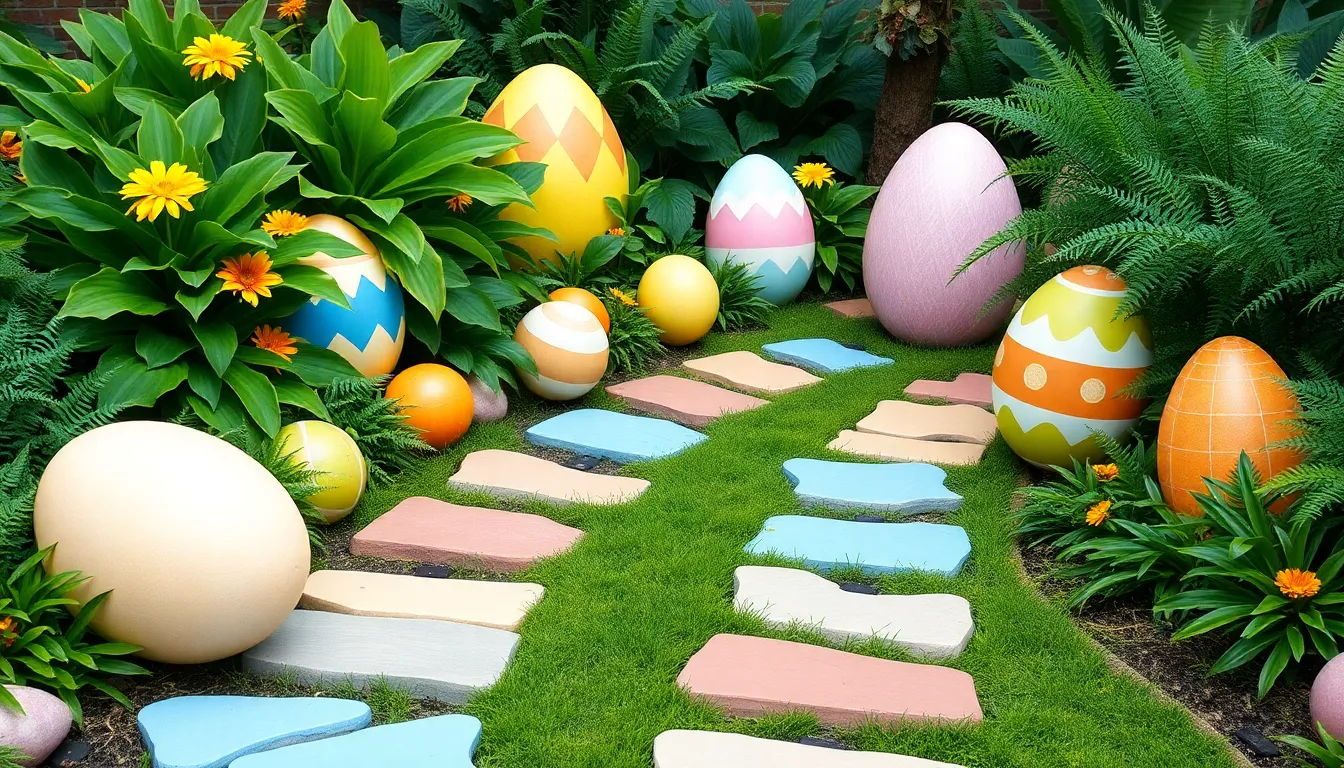
Transform your Easter garden into an enchanting pathway that guides visitors through a magical egg hunting adventure. Creating a vibrant route through your outdoor space adds excitement and structure to traditional Easter celebrations.
Install Oversized Decorative Easter Eggs
Giant decorative eggs serve as stunning focal points along your Easter garden path, creating visual anchors that draw the eye forward. We recommend crafting DIY giant eggs using large plastic shells from create stores, then decorating them with joint compound, acrylic paint, and creative designs that match your garden’s color scheme. Fill these oversized eggs with sand or small rocks to ensure they remain stable against spring winds and won’t topple during your celebration.
Budget-conscious gardeners can create impressive displays by purchasing 15-inch eggs from discount retailers and transforming them into high-end looking decorations. Paint these eggs in soft pastels like lavender, mint green, and butter yellow to complement your spring flowers. Position larger eggs at pathway intersections or garden corners where they’ll have maximum visual impact.
Create Hidden Egg Nooks Among Plants
Strategic plant selection makes hiding Easter eggs throughout your garden both easy and exciting for hunters of all ages. Choose plants with dense foliage like hostas, ferns, or ornamental grasses that provide natural camouflage for colorful eggs. Large-leafed plants such as elephant ears or caladiums create perfect hiding spots while adding tropical flair to your Easter display.
Creative hiding locations extend beyond simple plant cover to include decorative garden elements. Hollow logs, decorative birdhouses, and garden sculptures offer unique concealment opportunities that surprise and delight egg hunters. Place small eggs inside fairy garden accessories or miniature wheelbarrows to create whimsical discovery moments along your pathway.
Use Pastel-Colored Stepping Stones
Decorative stepping stones painted in Easter pastels guide visitors naturally through your garden while maintaining the festive theme. Paint existing concrete pavers with outdoor acrylic paint in soft pinks, blues, and yellows, then add Easter-themed stencils or hand-painted designs like bunny silhouettes or spring flowers. Seal painted stones with weather-resistant coating to preserve their beauty throughout multiple seasons.
Arrange these colorful stones in gentle curves rather than straight lines to create a more organic garden pathway experience. Space stones approximately 18 to 24 inches apart for comfortable walking, and consider adding small solar lights between stones for evening egg hunts. Connect different garden areas with branching stone paths that lead to various egg hiding zones, creating multiple discovery routes for your Easter celebration.
Plant a Spring Flower Garden in Easter Colors
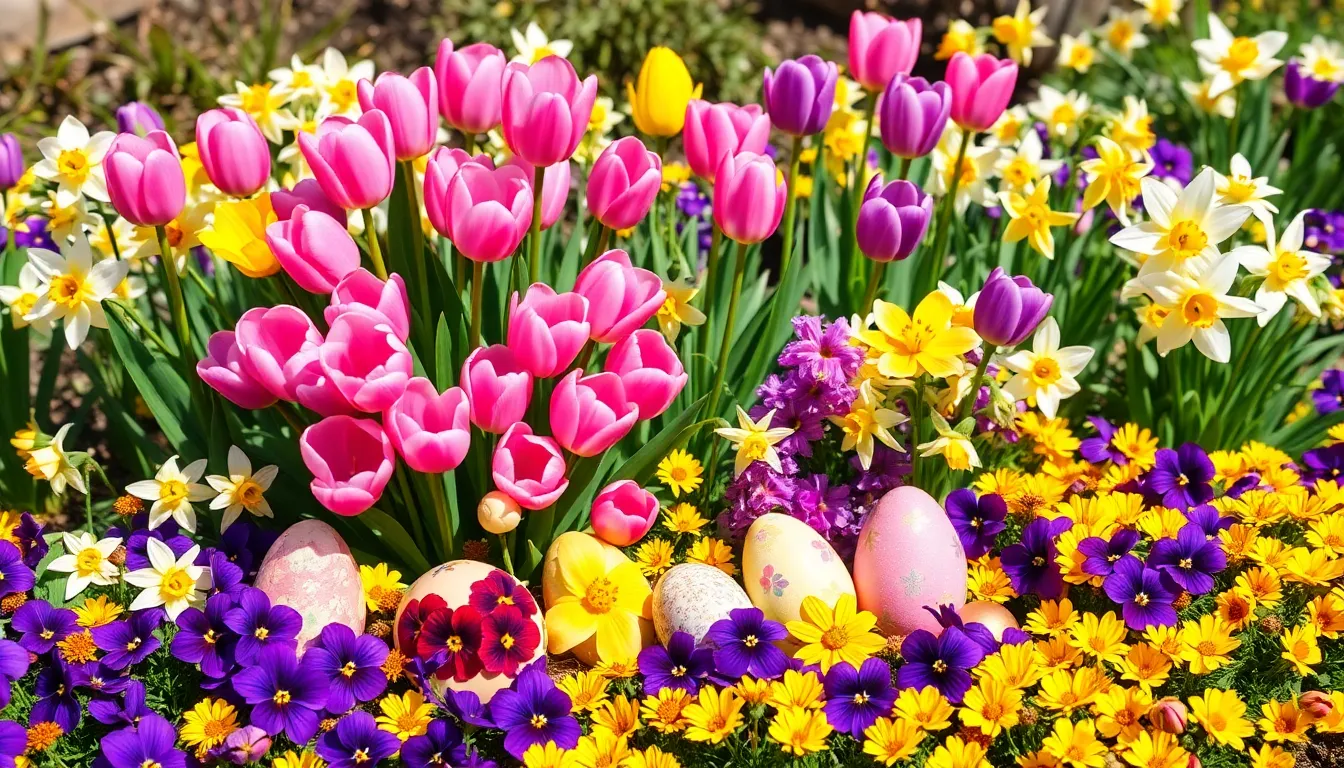
Building on our decorative garden displays, we can enhance the festive atmosphere by selecting flowers that naturally complement the Easter season. Spring blooms in traditional Easter hues create a stunning foundation for our seasonal celebration.
Choose Tulips in Pink, Purple, and Yellow
Tulips serve as the iconic centerpiece for any Easter flower garden. These spring favorites naturally bloom during Easter season and offer the perfect color palette for our festive display. Pink tulips add romantic charm to garden beds, while purple varieties create dramatic focal points near our bunny displays.
Yellow tulips brighten shadowy corners and complement the golden tones of decorative Easter eggs we’ve placed throughout the space. We can plant different tulip varieties in clusters for maximum visual impact, creating waves of color that guide visitors along our Easter egg hunt path.
Timing matters when planting tulips for Easter blooms. Most varieties need 12-16 weeks of cold treatment, so we should plant bulbs in late fall for perfect spring flowering. Darwin hybrid tulips and triumph tulips offer the most reliable blooms and longest-lasting displays for our Easter garden celebration.
Add White Daffodils for Classic Appeal
White daffodils provide classic elegance that symbolizes renewal and new beginnings. These timeless flowers complement our colorful tulip displays while maintaining the traditional Easter aesthetic. Their bright white petals create stunning contrast against darker foliage and enhance the visibility of hidden Easter eggs.
Planting white daffodils requires minimal maintenance once established. These perennial bulbs naturalize easily, returning year after year to grace our Easter celebrations. We can position them strategically around our bunny planters and decorative displays to create cohesive color schemes.
Narcissus varieties like ‘Mount Hood’ and ‘Ice Follies’ offer pure white blooms that last throughout the Easter season. Their sturdy stems resist spring winds, ensuring our garden maintains its polished appearance during outdoor celebrations and egg hunts.
Include Colorful Pansies and Violas
Pansies and violas deliver vibrant colors in purple, blue, white, and yellow varieties. These cool-weather champions thrive in spring conditions and provide continuous blooms throughout the Easter season. Their compact size makes them perfect for filling gaps between larger bulb plantings and decorative elements.
Versatility makes pansies ideal for container gardening and border plantings. We can use them in our Easter-themed planters alongside seasonal decorations, or plant them directly in garden beds to create colorful carpets beneath our decorative displays. Purple pansies echo traditional Easter colors, while yellow varieties brighten shaded areas.
Cold tolerance ensures pansies continue blooming through unpredictable spring weather. These hardy flowers withstand late frosts that might damage other spring annuals, making them reliable choices for our Easter garden displays. Their cheerful faces add whimsical charm that perfectly complements our bunny statues and egg decorations.
Build a Charming Easter Fairy Garden Corner
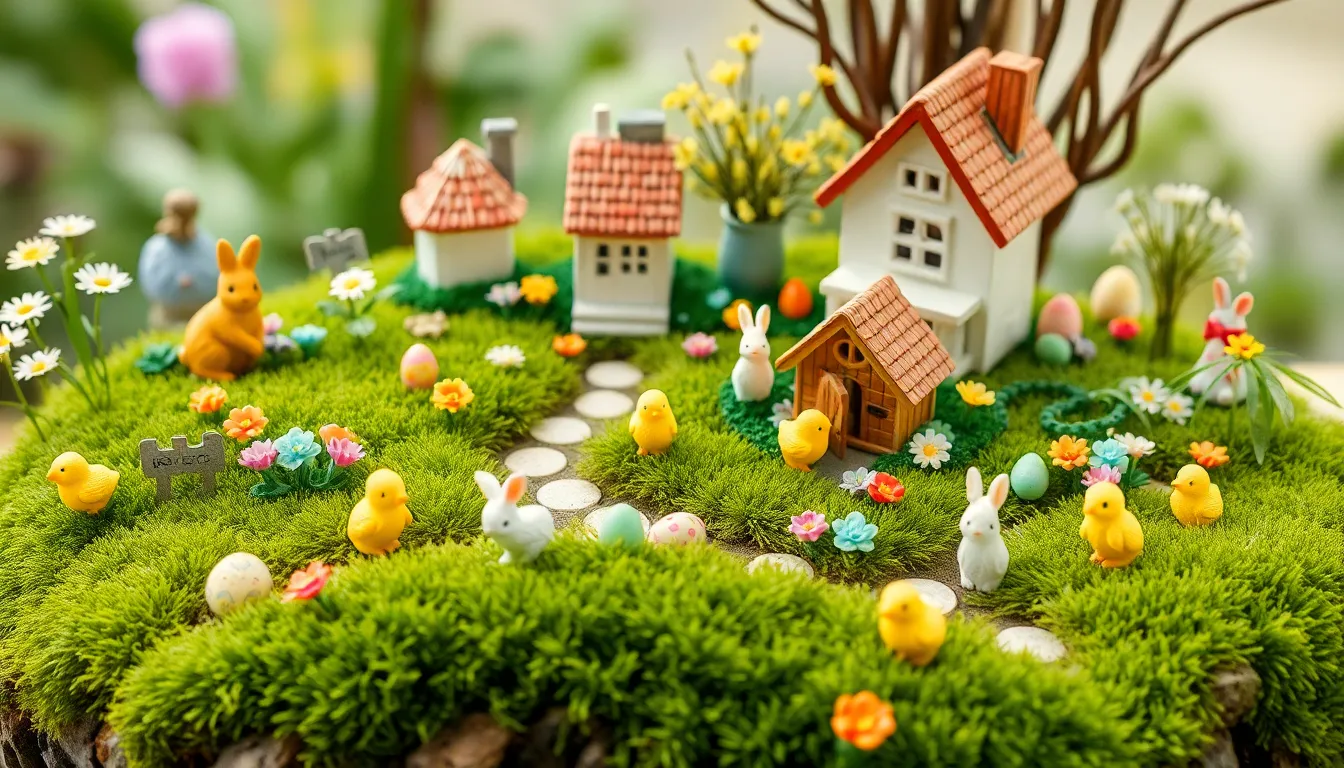
Creating a miniature Easter wonderland adds magical charm to our outdoor spaces while captivating visitors of all ages. These small-scale garden features combine whimsical elements with festive Easter themes to create enchanting displays.
Construct Miniature Easter Village Scenes
Miniature houses become the foundation for our Easter village displays, creating structured focal points that tell seasonal stories. We position small cottages throughout our garden beds, arranging them at varying heights to create visual depth and interest. Tiny furniture pieces like benches, wheelbarrows, and garden tools add authentic village charm while maintaining the Easter theme.
Small figurines transform these static scenes into lively Easter celebrations filled with character and movement. Easter-themed figures such as bunnies carrying baskets, chicks emerging from eggs, and families enjoying picnics bring our village to life. We cluster these miniature residents around the houses, creating natural gathering spots that mirror real community interactions.
Add Tiny Bunny and Chick Figurines
Bunny figurines serve as the primary characters in our Easter fairy garden, positioning them strategically throughout the display for maximum impact. We place larger bunny statues near the entrance to welcome visitors, while smaller figurines hide among plants and decorative elements. Different poses and expressions create ever-changing storytelling opportunities, from bunnies reading books to others tending miniature gardens.
Chick figurines complement the bunny characters while adding bright yellow accents to our Easter palette. These small yellow figures work particularly well when grouped in families or placed near miniature nesting areas. We position them emerging from decorated eggs or gathering around tiny water features to create natural scenes that capture the essence of spring renewal.
Create Mini Garden Paths with Moss
Moss pathways connect our fairy garden elements while providing natural texture and authentic woodland appeal. We lay down strips of preserved moss between our miniature houses and figurines, creating winding trails that guide visitors through our Easter display. The soft green color provides perfect contrast against pastel Easter decorations while maintaining an organic garden feel.
Small stones and pebbles enhance our moss pathways, adding definition and preventing the natural materials from shifting over time. We border our moss trails with tiny river rocks or decorative pebbles, creating clear boundaries that separate different areas of our fairy garden. These stone accents also provide drainage for the moss while adding textural interest that complements our miniature village scenes.
Craft DIY Easter Garden Decorations
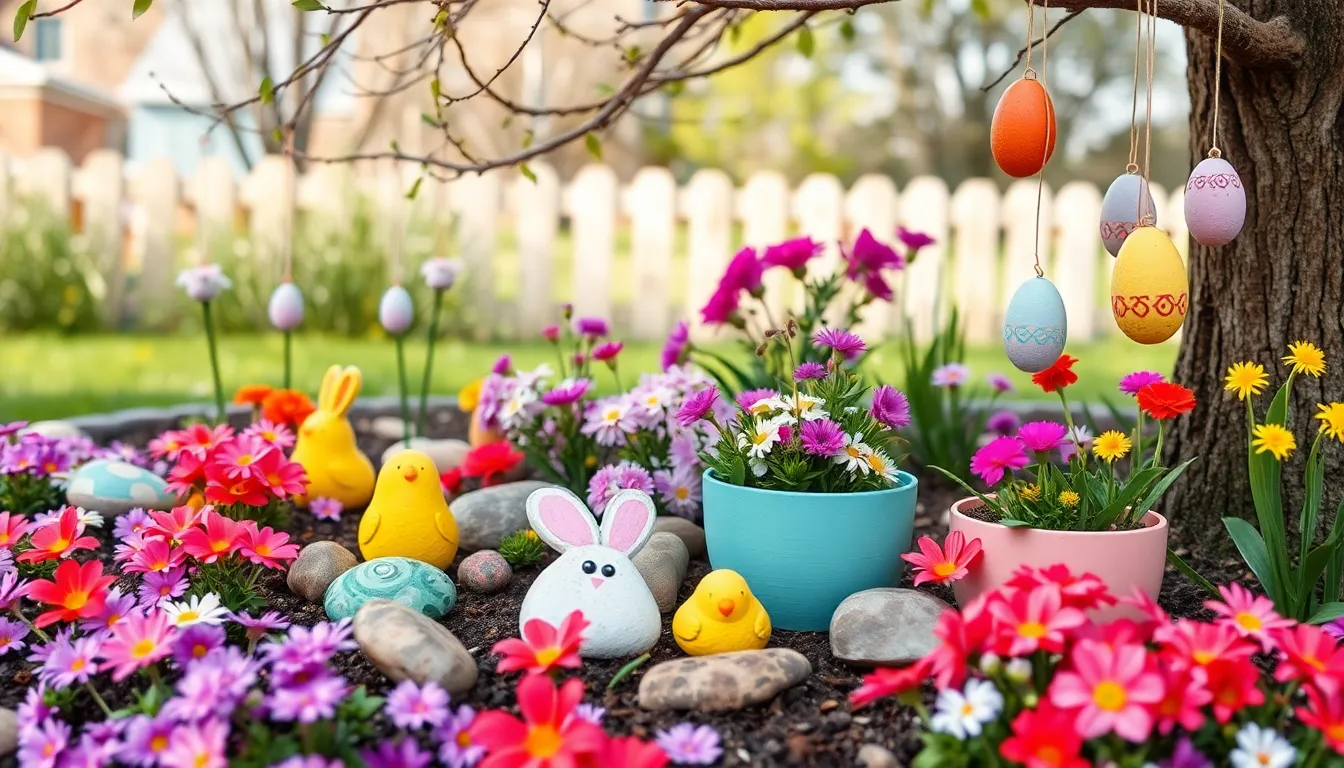
We can transform our outdoor spaces into festive Easter wonderlands with simple DIY decorations that showcase our creativity. These handmade elements add personal charm while celebrating the season’s joy.
Make Painted Rock Easter Characters
Painted rocks bring whimsical charm to our Easter garden displays with minimal effort and maximum impact. We’ll gather smooth garden rocks in various sizes to create adorable bunny, chick, and egg designs using acrylic paints in pastel colors.
Start by cleaning the rocks thoroughly and letting them dry completely before painting. Apply a base coat in soft pink, yellow, or white, then add details like bunny ears, chick beaks, or colorful egg patterns once the base dries. We can place these charming characters among our flower beds, tucked between plants, or lined along garden paths to create delightful surprises for visitors.
These painted rock Easter characters work perfectly as permanent decorations that withstand weather conditions throughout the season. Children love helping with this project, making it an excellent family activity that creates lasting memories while beautifying our outdoor space.
Create Upcycled Planter Easter Baskets
Upcycled planters transform forgotten containers into festive Easter basket displays that showcase our commitment to sustainability. We’ll repurpose old wooden baskets, crates, or even large plastic containers by painting them with chalk paint in soft pastels like lavender, mint green, or buttercream yellow.
Adding decorative elements elevates these simple planters into stunning Easter features. We can stencil rabbit silhouettes, attach faux bunny tails, or weave colorful ribbons through the basket weave for extra charm. Fill these transformed containers with Easter grass, small potted spring flowers like pansies or mini daffodils, and scattered decorative eggs for a complete Easter basket effect.
Large plastic Easter eggs serve as unexpected planters when we cut them in half and add drainage holes. These cheerful containers work perfectly for showcasing individual spring blooms while adding playful pops of color throughout our garden beds.
Design Handmade Garden Wind Chimes
Handmade wind chimes add gentle melodies to our Easter garden while creating beautiful visual focal points. We’ll create these musical decorations using natural materials like driftwood pieces, smooth stones, or painted wooden eggs suspended on fishing line or thin rope.
Create unique Easter themed chimes by painting wooden eggs in pastel colors and hanging them at varying lengths from a sturdy branch or piece of driftwood. The gentle breeze creates soft tinkling sounds while the colorful eggs catch sunlight and cast dancing shadows throughout our garden space.
We can enhance these wind chimes with additional natural elements like shells, small bells, or carved wooden bunny shapes. Position them near seating areas or hanging from tree branches where they’ll catch the wind and provide soothing background music for our outdoor Easter celebrations.
Establish an Easter Herb and Vegetable Garden
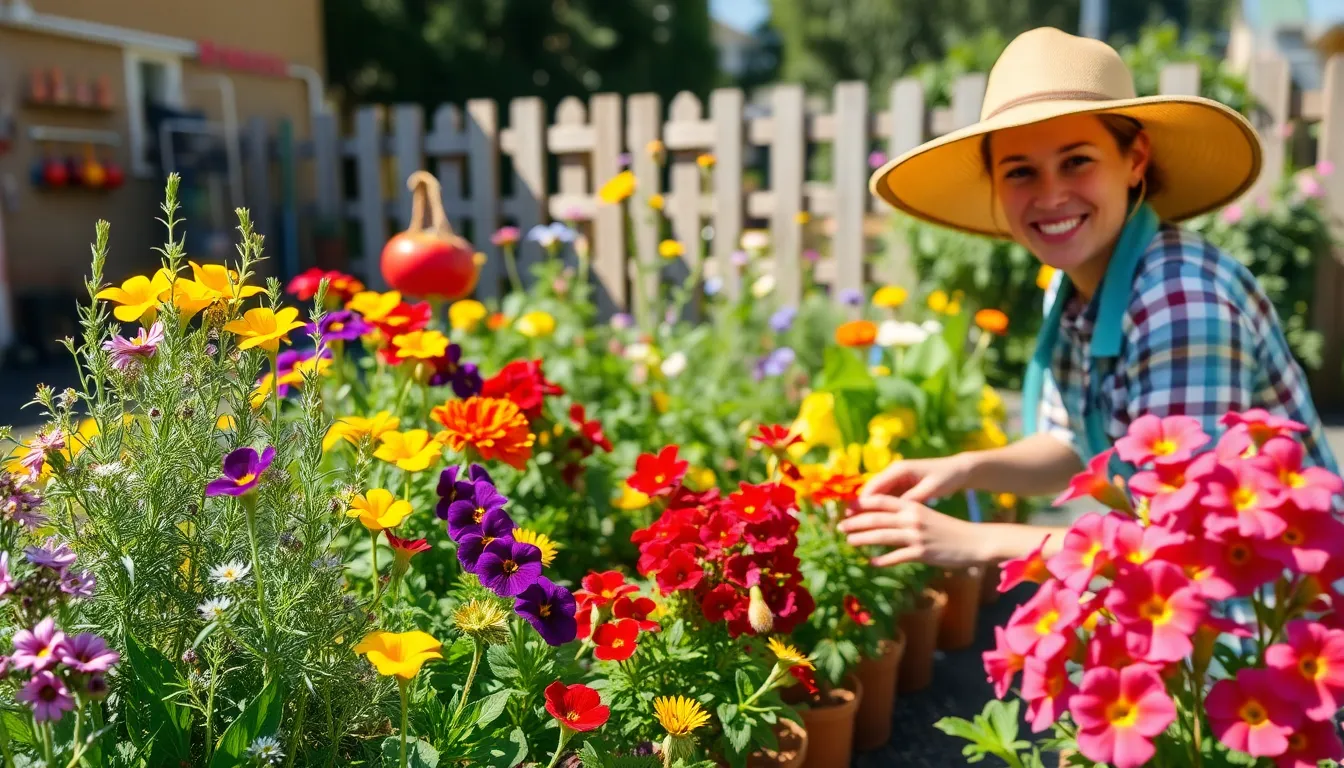
Creating an edible Easter garden combines the joy of seasonal celebration with the practical benefits of homegrown ingredients. This functional approach to Easter gardening lets us cultivate fresh herbs and vegetables that’ll enhance our holiday meals while maintaining the festive spirit.
Plant Traditional Easter Herbs Like Rosemary
Rosemary stands as the quintessential Easter herb due to its deep symbolism of remembrance and friendship. We can grow this fragrant herb in containers or plant it directly in our garden beds for year-round harvests. Thyme offers another excellent choice for our Easter herb collection, bringing earthy flavors that complement traditional holiday dishes.
Chives provide a mild onion flavor that’s perfect for Easter salads and egg dishes. These hardy perennials grow easily in most climates and produce delicate purple flowers that add visual appeal to our garden. Planting these herbs in March ensures they’ll be ready for our Easter feast preparations.
Growing rosemary in pots allows us to move the plants indoors during harsh weather conditions. The herb’s needle-like leaves release aromatic oils when brushed against, creating a sensory experience as we tend our Easter garden.
Grow Spring Vegetables for Easter Meals
Spring vegetables planted around Easter time provide fresh ingredients for our holiday table. Beans offer protein-rich additions to our Easter meals and can be planted directly in the soil once temperatures consistently stay above 50°F. Peas thrive in cooler spring weather and produce sweet pods that children love to harvest.
Spinach grows quickly in spring conditions and provides nutritious greens for salads and side dishes. We can succession plant spinach every two weeks to ensure continuous harvests throughout the Easter season. Lettuce varieties like buttercrunch and romaine establish easily in spring gardens.
Planting these vegetables six to eight weeks before Easter ensures they’ll be ready for harvest during our celebrations. Cool-season crops like spinach and peas actually prefer the mild temperatures of early spring over summer heat.
Create Edible Flower Borders
Edible flowers transform our Easter garden into a colorful feast for both eyes and taste buds. Violas produce delicate flowers in purple, yellow, and white that make stunning garnishes for Easter desserts and salads. Pansies offer larger blooms with distinctive “faces” that children find delightful.
Nasturtiums provide peppery-flavored flowers in bright oranges, reds, and yellows that complement spring color schemes. These climbing or trailing plants work well as border plantings or in hanging containers. We can harvest the flowers throughout the growing season for continuous culinary use.
Creating borders with these edible flowers requires spacing plants 6-8 inches apart for proper air circulation. The flowers can garnish Easter cakes, float in punch bowls, or add color to spring salads. Planting edible flowers near our herb and vegetable sections creates a cohesive edible industry design.
Install Easter-Themed Garden Lighting
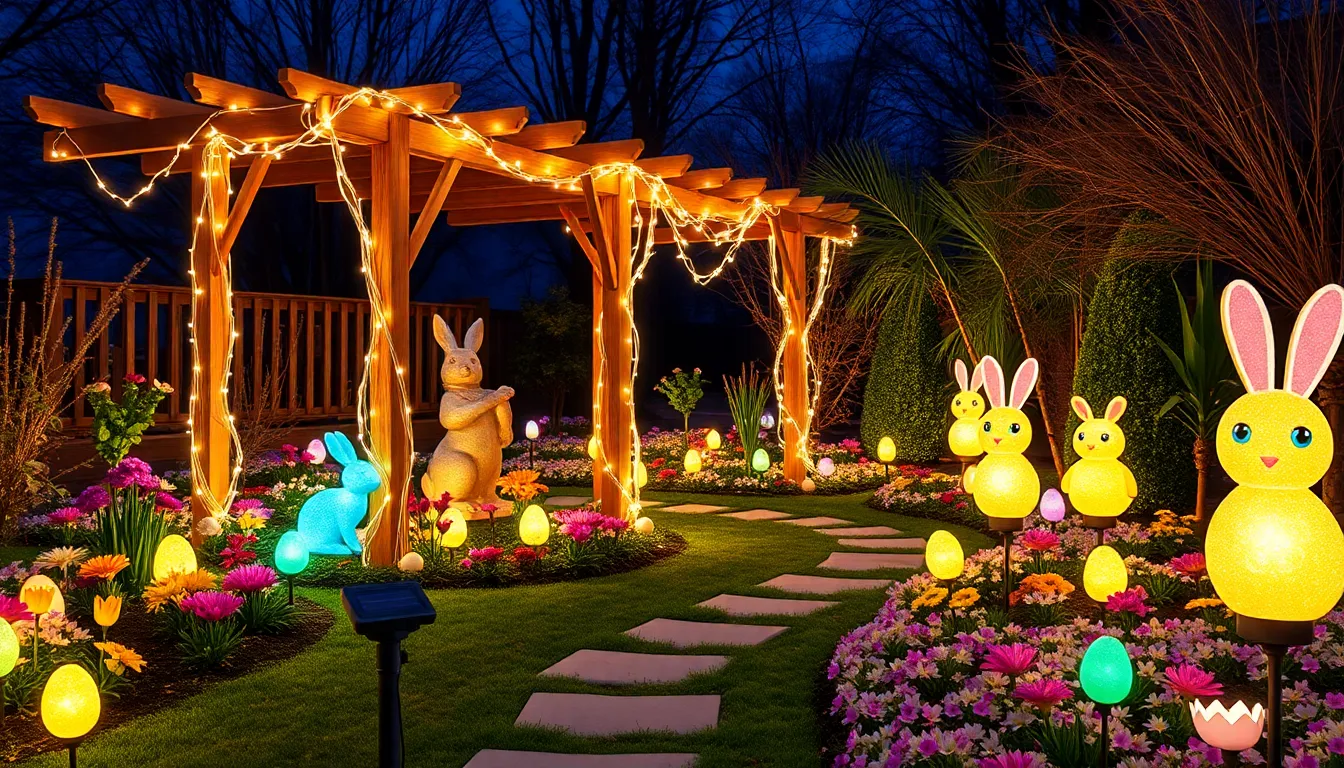
Now that we’ve established our beautiful Easter displays with flowers and decorations, let’s extend the magic into the evening hours with festive garden lighting. Proper illumination transforms our Easter garden into an enchanting wonderland that can be enjoyed long after sunset.
String Pastel-Colored LED Lights
Pastel-colored LED lights bring soft elegance to our Easter garden displays while maintaining energy efficiency throughout the season. These gentle hues in pink, blue, yellow, and green perfectly complement traditional Easter color schemes and create magical ambiance without overwhelming our existing decorations.
We can drape these versatile lights across pergolas to create overhead canopies of soft color that illuminate dining areas below. Wrapping them around garden features like arbors, trellises, or even our decorative bunny statues adds dimension and highlights key focal points. Placing pastel LEDs inside clear lanterns or mason jars creates stunning tabletop accents for outdoor Easter gatherings.
Add Solar-Powered Easter Character Lights
Solar-powered Easter character lights offer sustainable charm while requiring zero maintenance once installed in our garden spaces. These delightful fixtures charge automatically during daylight hours and illuminate pathways with whimsical rabbits, chicks, and egg shapes when darkness falls.
We recommend positioning these character lights along garden borders to define spaces and guide guests through our Easter displays safely. Clustering three to five solar bunny lights around our fairy garden corner creates storytelling opportunities that captivate children during evening visits. Installing them near our vegetable and herb gardens provides practical pathway lighting while maintaining the festive Easter theme throughout our outdoor space.
Place Illuminated Garden Stake Decorations
Illuminated garden stake decorations provide instant festival atmosphere with simple ground insertion and immediate visual impact. These versatile pieces feature lighted Easter eggs, glowing bunnies, and other themed shapes that transform ordinary garden beds into spectacular light displays.
We can create stunning walkway borders by spacing illuminated stakes every three to four feet along paths leading to our main Easter garden areas. Inserting taller lighted egg stakes behind our spring flower beds adds depth and draws attention to blooming tulips and daffodils during evening hours. Positioning shorter bunny stakes around our container gardens creates intimate lighting zones that highlight our pastel plantings while providing gentle illumination for nighttime enjoyment.
Set Up an Outdoor Easter Celebration Space
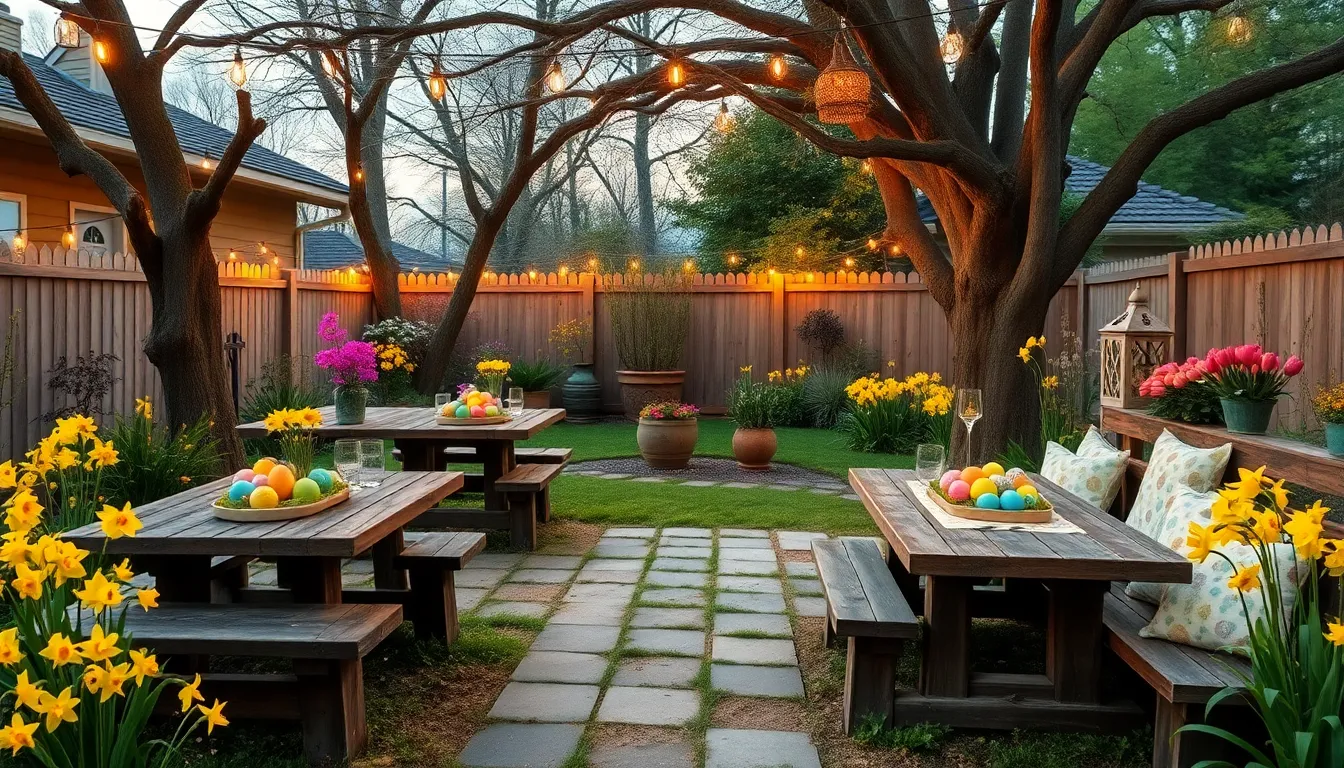
We’re ready to transform our garden lighting into a complete celebration venue that welcomes family and friends. Creating dedicated spaces for gathering and dining ensures our Easter festivities remain comfortable and memorable throughout the day.
Create Seating Areas with Garden Benches
Garden benches serve as both functional seating and decorative focal points that anchor our celebration space. We recommend positioning these versatile pieces in a semi-circle formation to encourage conversation and create an intimate gathering atmosphere. Arranging benches under mature trees provides natural shade while establishing cozy conversation nooks that guests will gravitate toward.
Comfortable cushions in pastel or spring-themed patterns instantly elevate the appeal of standard garden benches. These soft accessories transform basic seating into welcoming spots where family members can relax between egg hunting activities. Choosing weather-resistant cushion covers ensures our seating remains inviting even if morning dew or light spring showers threaten our celebration.
Strategic bench placement creates natural flow patterns that guide guests through our Easter garden displays. We position benches near our fairy garden corners and flower borders to provide rest stops where visitors can appreciate the detailed decorations we’ve created. Multiple seating areas scattered throughout the space prevent overcrowding in any single location.
Design Natural Easter Egg Display Tables
Rustic wooden tables form the perfect foundation for showcasing our Easter egg collections in an organic garden setting. We repurpose old garden carts and weathered wooden surfaces to create authentic display bases that complement our outdoor theme. These natural materials blend seamlessly with surrounding plantings while providing sturdy platforms for our decorative arrangements.
Real or faux eggs arranged in decorative nests create stunning centerpieces that capture the essence of spring renewal. We layer eggs in vintage birdcages and tiered displays to add vertical interest and depth to our table arrangements. Incorporating different egg sizes and textures prevents our displays from appearing flat or monotonous.
Fresh-cut spring flowers such as daffodils, tulips, and hyacinths surround our egg displays with vibrant seasonal color. These blooms bridge the gap between our decorative elements and living garden features, creating cohesive visual connections. Small bunny figurines and garden stakes with Easter motifs add whimsical touches that delight children and adults alike.
Add Weather-Resistant Easter Tablescapes
Outdoor tablecloths and runner cloths made from waterproof or UV-resistant fabric protect our dining surfaces while maintaining festive appearances. We select materials that withstand wind, sun, and unexpected rain showers without losing their vibrant colors or deteriorating quickly. These durable textiles ensure our table settings remain attractive throughout extended outdoor celebrations.
Ceramic or resin dinnerware replaces fragile indoor pieces that might break in outdoor conditions or blow away in spring breezes. We choose plates, bowls, and serving pieces specifically designed for patio use, ensuring they complement our Easter color scheme while providing practical functionality. Weather-resistant centerpieces anchor our table decorations and prevent lightweight items from shifting during windy conditions.
Fairy lights, lanterns with LED candles, and string lights create magical ambiance as daylight fades into evening hours. These illumination elements extend our celebration time while adding sparkle to our outdoor dining experience. We secure all lighting elements properly to prevent damage from wind and ensure safe operation throughout our Easter gathering.
Conclusion
We’ve shown you that creating a stunning Easter garden doesn’t have to expensive or require expert gardening skills. With these creative ideas you can transform any outdoor space into a festive celebration that brings joy to family and friends.
The beauty of Easter garden decorating lies in its flexibility – you can mix and match elements to suit your space and style. Whether you choose whimsical bunny displays colorful egg hunt paths or charming fairy garden corners each addition helps create lasting memories.
Start with one or two ideas that speak to you most and gradually build your Easter wonderland. Your garden will become the perfect backdrop for celebrating this special season while creating a space that neighbors will admire all spring long.
Frequently Asked Questions
What budget do I need to create an Easter garden display?
Creating a festive Easter garden doesn’t require a large budget. The article emphasizes that simple DIY projects using creativity and colorful elements can transform any outdoor space. You can make painted rock characters, upcycled planters from old containers, and handmade decorations using materials you likely already have at home.
Can I create an Easter garden in a small space like a balcony?
Absolutely! The article specifically mentions that Easter garden decorations work well for both large backyards and small balcony gardens. You can use container gardens, small bunny planters in pastel colors, and miniature fairy garden corners to create a charming Easter display in any sized space.
What flowers work best for an Easter-themed garden?
The best Easter flowers include tulips in pink, purple, and yellow as iconic centerpieces, white daffodils for classic elegance, and colorful pansies and violas for their vibrant hues and cold tolerance. These flowers complement the Easter season perfectly and require minimal maintenance while providing maximum visual impact.
How do I create an Easter egg hunt path in my garden?
Design a colorful egg hunt path by installing oversized decorative eggs as focal points, using dense foliage plants to hide smaller eggs, and laying pastel-colored stepping stones to guide visitors. Strategic plant selection and unique decorative elements create surprise concealment spots while maintaining the festive theme.
What can I grow in an Easter herb and vegetable garden?
Traditional Easter herbs like rosemary, thyme, and chives enhance holiday meals, while spring vegetables such as beans, peas, and spinach can be harvested for Easter celebrations. Edible flowers like violas, pansies, and nasturtiums add beauty and serve culinary purposes as dish garnishes.
How can I add lighting to my Easter garden display?
Enhance your Easter garden with pastel-colored LED lights across pergolas and garden features, solar-powered Easter character lights for sustainable pathway illumination, and illuminated garden stake decorations. These lighting elements create magical ambiance and extend enjoyment of displays into evening hours.
What are some easy DIY Easter garden decoration ideas?
Simple DIY projects include painting smooth garden rocks in pastel colors to create bunny, chick, and egg characters, making upcycled planter baskets from old containers, and crafting handmade wind chimes using natural materials. These projects add personal creativity without requiring extensive crafting skills.
How do I create a fairy garden for Easter?
Build a charming Easter fairy garden by constructing miniature village scenes with small cottages and tiny furniture pieces. Add bunny and chick figurines strategically placed for storytelling opportunities, and use moss pathways to connect elements while providing natural texture throughout the enchanting display.

